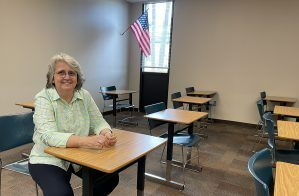
As the rising cost of college continues to push higher education out of reach, programs that allow high schoolers to earn college credits are soaring in popularity. Many dual enrollment programs traditionally have been offered within public and private high schools, while others have allowed students to attend classes on the campus of the participating college.
Now, colleges such as Pensacola State College in Florida’s Panhandle are bringing entire high schools to their campuses for dual enrollment, offering students the chance to earn an associate degree alongside a high school diploma.
Pensacola State College Charter Academy opened Aug. 8 on the college’s Warrington campus to about 150 students from military families and students deemed at risk of dropping out.
“(Military) children may be in one school for two years, another one for two years, another one for two years. Their parents are always looking for quality opportunities for their children, so this gives them another choice,” Capt. Tim Kinsella, base commander of Naval Air Station Pensacola, told the Pensacola News Journal.
“It gives them an opportunity that is something more than just a high school because of the opportunities that this presents. It’s almost an attraction for military families to come here.”
Pensacola State College Charter Academy’s inaugural class is comprised of high school juniors and seniors; sophomores will be accepted in the fall of 2024. About 80% of students were required to meet charter school entry requirements, while 20% of the space was reserved for students specifically at risk of dropping out. Military families are exempt from meeting the entry requirements.
Authorized by the Escambia County School District, the academy got a funding boost with a $100,000 donation from the Gulf Power Foundation toward a technology innovations center, housed within the school, which will offer students access to virtual simulations of various types of careers.
“It’ll be more than just access to the internet,” academy president Ed Meadows said.
Karen McCabe, a former school principal in New York and director of the South Santa Rosa Center at Pensacola State, was tapped to be principal at the new charter academy. During her tenure at the Santa Rosa Center, she worked with two of the largest local high schools to offer dual enrollment with the college and helped to increase participation.
The academy will focus heavily on careers, particularly those grounded in science, technology, engineering and math. Students will be required to complete a capstone project related to their desired career path prior to graduation.
“They will do some heavy research with an individual in that field and possibly shadow them,” McCabe told Pensacola’s WEAR-TV.
Pensacola State College Charter Academy is part of the dual enrollment boom that has taken the nation by storm in recent years. Between the 2002-03 and 2010-11 academic years, the number of high school students taking college courses for credit increased by 68% to nearly 1.4 million according to federal data. By 2015, nearly 70% of high schools offered dual enrollment, according to the Government Accountability Office.
Hailed as game-changers for lower-income students, the programs have allowed many to get a free head start on a college degree they otherwise might not be able to afford. The programs also help local colleges, which have seen enrollments plummet since the end of the Great Recession in 2010.
In Florida, an 8-year-old legal glitch that left no funding for nonpublic schools to provide dual enrollment resulted in a 60% drop in enrollment among independent and faith-based schools. The Florida Legislature in 2021 corrected the problem by passing SB 52, which set aside $15.5 million in state money to cover the costs for homeschooled and private school students who participate in dual enrollment programs by taking courses from a partnering college or university.
The legislation was a top priority of private school leaders, who had been forced to stop offering dual enrollment at their high schools because of the costs. Many, including Steve Hicks, vice president of operations for Center Academy, which operates 10 campuses in Florida for students with learning disabilities, praised lawmakers for passing the legislation.
“Studies clearly show that students who have an opportunity to take dual enrollment courses are more likely to attend a college after high school,” Hicks said. “The fact that so many families, like the ones we serve, were not able to take advantage of this opportunity due to financial or other reasons was extremely frustrating.”


